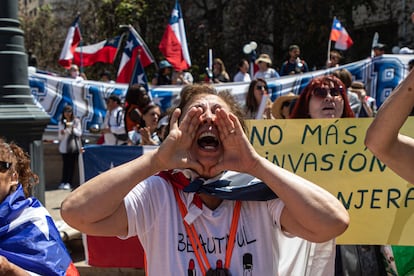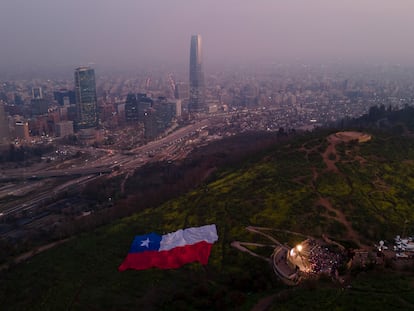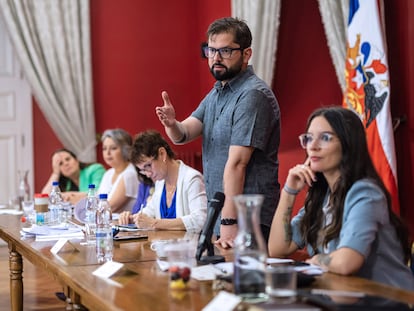The second front in Chile’s elections: will the far right defeat the traditional right?
The opposition to President Gabriel Boric is waging its own battle for hegemony: the Chile Vamos bloc, led by a new generation, is facing the extremist Republican Party


The results of the Constitutional Council elections to be held on May 7 in Chile will clear up several political incognitos hanging over the country but in all likelihood the primary one is not how the ruling party of President Gabriel Boric and the left will fare, but what will happen among the opposition: will the extreme right of the Republican Party (PLR), led by José Antonio Kast, succeed in surpassing the traditional right that sustained the two administrations of Sebastián Piñera (2010-2014 and 2018-2022)? This is the main internal battleground of an election marked by voter apathy but in which, due to the mandatory nature of the ballot, participation levels are expected to be high. Some analysts, such as Pepe Auth, have even predicted that the ultra-conservative formation could come out of the vote as the main political force in Chile, 50 years after the coup d’état led by Augusto Pinochet, a figure some in the Republican Party have suggested was the country’s savior.
The traditional right in Chile groups together three parties: the Independent Democratic Union (UDI), National Renewal (RN) and Political Evolution (Evópoli). These formations are currently led by a new political generation, who have taken the mantle from those who played a leading role in the transition to democracy and whose links to the dictatorship were still fresh. After the failure of the left on a referendum for the drafting of a new Constitution — last September, 62% of voters rejected the proposal — the traditional right fulfilled its previous commitment to facilitate a new path toward changing the political charter drawn up the Pinochet regime in 1980. “The Chilean right wing is committed to the continuity of the constitutional process,” said UDI leader Javier Macaya in September.
The Republican Party, however, did not go so far, maintaining its original position of not wanting to alter the Constitution drafted during the dictatorship, which underwent a dozen reforms after the transition to democracy. The far-right formation, whose leader won the first round of the 2021 presidential elections against Boric in 2021, has managed to gather momentum due to a shift to the right among the traditional parties. Forecasts indicate that the main loser in a PLR sweep would be the UDI, the most ideological of the parties on the Chilean right.
“The UDI will take the most punishment because it is evident that many of its supporters, on this occasion, are voting for Republican candidates. Quite a few are also voting for the [populist] Party of the People,” historic UDI leader, Pablo Longueira, said in a letter to his party’s support base earlier in the week. For Longueira, “Republicans will reap the benefits of insecurity [surrounding the assassinations of police officers and growing concerns over the immigration crisis]. In this election, it will be the party that garners the most votes. It could even surpass, as in the first round of the presidential elections, Chile Vamos [ChV, the traditional right-wing bloc]. If so, on this occasion it will have a very strong impact inside the UDI, RN and Evópoli.”

A suicidal gamble
Longueira and other leading right-wing figures have openly voiced their concerns about the threat posed by the Republican Party. Former president Piñera this week met with other rightist leaders to analyze the different electoral forecasts. There was even talk of the possibility that Kast’s PLR could surpass the entire traditional right-wing bloc in terms of percentage of votes and number of members elected to the Constitutional Council on its own. What seems highly probable, however, is that both the traditional and the extreme right will band together 30 representatives on the council — three-fifths of the total of 50 seats — precisely the necessary number to set the norms of the constitutional body. What is less clear is to what extent the two right-wing factions will find common ground, given the PLR has historically been in favor of maintaining the 1980 Constitution. For Boric’s government, a fruitful dialogue between the two would provide a complex scenario.
“It is likely that the ultra-right will obtain a relatively good result, close to 20% of the electorate, as the current political situation favors the iron fist agenda. Kast is a well-known figure who has campaigned for his ticket throughout the country and government support is not in a good moment,” says Cristóbal Rovira, a PhD in political science at the Humboldt University of Berlin and lead author of the research paper “Support and rejection of the far-right in Chile.”
“If that comes to pass, we should not be surprised if a part of the conventional right wing decides on a change of strategy. Instead of following the discourse of differentiation [in which Macaya has played an important role], they could seek a rapprochement and even symbiosis with the ultra-right,” notes Rovira. In the view of the analyst, the reality in other countries provides evidence that this would represent a very risky, and probably suicidal, gamble: “A rapprochement between the conventional right and the ultra-right favors the latter above all, as it legitimizes itself as a political actor and, therefore, gains more space for its ideas. If so, sooner rather than later, the ultra-right would become the scriptwriter of the movie and the conventional right would be subordinated to the position of a supporting actor,” he says, drawing parallels with the Republican Party in the U.S., where the moderate faction has been sidelined by the more radical elements.
Rovira points to a key fact, one feared by the left, the ruling party and Boric’s own government: the effects of a toughening of the positions of the conventional right, which, in his opinion, would hinder the functioning of the body in charge of drafting a new Constitution. “It would end up being very complex to achieve transversal agreements to produce a text that represents the diversity of the country. Seen in this way, one of the unexpected consequences of a potential symbiosis between the ultra-right and the conventional right would be the delegitimization of the constitutional process, to such an extent that the final product could end up being rejected in the plebiscite of December of this year.” This is a recurring nightmare for the Boric administration: that the current constitutional process may end up with a text largely the same as the 1980 Constitution, or worse, but legitimized by the voting public in a referendum — that it will be partisan in favor of the right unlike the previous process, which was strongly inclined toward the left.
This Sunday, Chile could begin to shape the type of right wing the South American country will have. Kast’s party gained 15 deputies and two senators in 2021, and a favorable result for the PLR on May 7 would place them in a strong position ahead of the 2024 regional elections and the 2025 parliamentary and presidential campaign. This has set alarm bells ringing among the traditional right. “If there is no result that favors cooperation and agreement, the panorama described by [Chilean intellectual] Nicanor Parra would occur: that the [extreme] left and the [extreme] right, united, will never be defeated,” one of the new leaders of the UDI, Jaime Bellolio, recently told EL PAÍS.
Sign up for our weekly newsletter to get more English-language news coverage from EL PAÍS USA Edition
Tu suscripción se está usando en otro dispositivo
¿Quieres añadir otro usuario a tu suscripción?
Si continúas leyendo en este dispositivo, no se podrá leer en el otro.
FlechaTu suscripción se está usando en otro dispositivo y solo puedes acceder a EL PAÍS desde un dispositivo a la vez.
Si quieres compartir tu cuenta, cambia tu suscripción a la modalidad Premium, así podrás añadir otro usuario. Cada uno accederá con su propia cuenta de email, lo que os permitirá personalizar vuestra experiencia en EL PAÍS.
¿Tienes una suscripción de empresa? Accede aquí para contratar más cuentas.
En el caso de no saber quién está usando tu cuenta, te recomendamos cambiar tu contraseña aquí.
Si decides continuar compartiendo tu cuenta, este mensaje se mostrará en tu dispositivo y en el de la otra persona que está usando tu cuenta de forma indefinida, afectando a tu experiencia de lectura. Puedes consultar aquí los términos y condiciones de la suscripción digital.
More information
Archived In
Últimas noticias
Alain Aspect, Nobel laureate in physics: ‘Einstein was so smart that he would have had to recognize quantum entanglement’
Imelda Castro, the woman who wants to rule the cartel battleground of Sinaloa
The new victims of the Republican war on Obamacare: Millions hit by soaring health insurance premiums
A country divided on migrant rights: Some US states expand protections while others restrict them
Most viewed
- David King, chemist: ‘There are scientists studying how to cool the planet; nobody should stop these experiments from happening’
- Reinhard Genzel, Nobel laureate in physics: ‘One-minute videos will never give you the truth’
- Oona Chaplin: ‘I told James Cameron that I was living in a treehouse and starting a permaculture project with a friend’
- Sinaloa Cartel war is taking its toll on Los Chapitos
- Mexico completes its trade shift with the entry into force of tariffs on China and countries without trade agreements










































